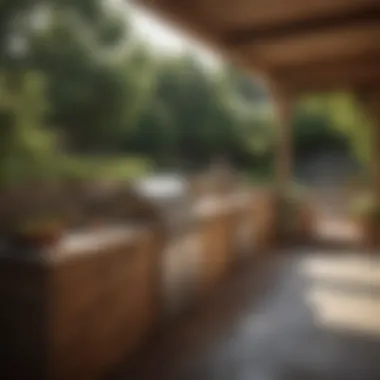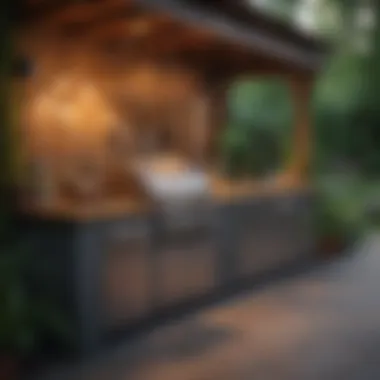Backyard Cooking Areas: Design and Evolution


Intro
Backyard cooking areas are becoming a significant trend in modern outdoor living. These spaces reflect the shift towards more versatile home designs where functionality and aesthetics are paramount. Homeowners no longer regard the backyard merely as an extension of the garden, but as an essential area for cooking, dining, and entertainment. This evolution is driven by a growing desire to create seamless connections between indoor and outdoor living environments. Individuals aim to enhance their quality of life through the integration of these spaces.
The concept of outdoor cooking areas encompasses a variety of design elements, equipment options, and materials. Each of these components plays a crucial role in creating a space that meets the desires and needs of the homeowner. Furthermore, the inclusion of sustainable practices in design reflects a broader societal trend towards environmental consciousness. Owners want not only an appealing area but also one that aligns with their values. Technology integration further elevates the potential for functionality and ease of use, catering to a contemporary lifestyle that values convenience.
By exploring these facets, this article will provide insights into how to design and execute an outdoor cooking area that is both practical and reflective of personal style.
Preamble to Backyard Cooking Areas
The backyard cooking area has gained significance in modern home design. This trend reflects a shift in lifestyle where outdoor living has become a vital extension of indoor spaces. Homeowners no longer view their yards as merely empty spaces. They consider them as areas for culinary experiences, gatherings, and social interactions. The design of these spaces has evolved from simple grills to comprehensive outdoor kitchens.
A well-planned backyard cooking area combines functionality and aesthetics. It’s not just about having a grill; it's about creating a destination. These areas now often include features such as built-in grills, pizza ovens, refrigeration, and ample counter space for meal prep. With the rise of outdoor dining, the integration of seating areas and dining surfaces enhances usability.
Furthermore, outdoor cooking offers benefits that are both practical and psychological. Cooking outdoors can improve air circulation, reduce indoor heat, and create an inviting atmosphere for gathering. This trend allows homeowners to engage with nature while preparing meals, creating a holistic cooking experience.
"Incorporating outdoor cooking spaces can transform social gatherings by fostering interaction and engagement among guests."
As the article unfolds, we will explore how these spaces are defined, their evolving appeal, and the key considerations for designing a functional and stylish outdoor kitchen.
Design Considerations
Design considerations are fundamental when creating a backyard cooking area. Such spaces are extensions of our homes, and by thoughtfully assessing the layout, materials, and aesthetics, one can achieve a harmonious blend of functionality and style. Design impacts not just the look but also the experience of outdoor cooking and entertainment. A well-designed setup serves the practical needs of cooking while also offering a pleasant atmosphere for social gatherings.
Assessing Available Space
Assessing the available space is the first step in designing an effective backyard cooking area. Understanding the dimensions and shape of the outdoor area informs decisions about the appliances and features that will fit within it. This assessment also includes considering any existing structures, landscaping, and utilities.
A crucial detail is to measure not only the area but also the height and any obstructing elements such as trees or fences. Adequate spacing ensures that the design can be practical; for instance, it will allow for safe distances between cooking areas and seating. Additionally, considering the natural flow of the land can enhance the usability of the area.
Choosing a Functional Layout
A functional layout is critical in backyard cooking areas. This layout should facilitate a smooth cooking process while promoting interaction among guests.
Workflow optimization
Workflow optimization refers to arranging elements in a way that enhances cooking efficiency. This is often achieved by positioning appliances close to one another to minimize unnecessary movement. For instance, aligning the grill, prep area, and sink can significantly reduce the time spent preparing meals.
The key characteristic of workflow optimization is the elimination of friction during cooking activities. It is a beneficial choice because it allows users to cook and serve meals more quickly. Unique features of this approach may include carefully planned pathways to avoid clutter and ensure straightforward access to often-used items.
Advantages include increased speed and less frustration, while disadvantages might include limitations on how large an area can be utilized if all elements are too close.
Zoning for cooking and dining
Zoning involves defining separate areas for cooking and dining. It contributes to the overall goal of creating a simultaneous cooking and entertaining experience. Each zone serves a particular function, with the cooking zone providing space for food preparation and grilling, while the dining zone focuses on seating and socializing.
The primary characteristic is that certain areas will be dedicated specifically to their functions. This makes it a popular choice for homeowners who value organization in their outdoor spaces.
The unique feature of zoning is the potential for effective traffic flow—guests can circulate between zones without disrupting the cooking process. The advantages include reduced chaos and a structured approach to hosting, while a drawback may be the need for more space to keep these zones operational.
Accessibility
Accessibility is vital in ensuring that all guests and family members can enjoy the space. This consideration relates to how easy it is for individuals to reach cooking, dining, and entertaining areas. An accessible design means that movement within the space is not hindered by physical barriers or misaligned elements.
The primary characteristic of accessibility is providing paths and surfaces that everyone can navigate with ease. This is a beneficial aspect of design, particularly for families with children or elderly guests.
A unique feature might be wider paths and adjustable furniture to accommodate different needs. The advantages of this consideration include promoting an inclusive environment, while the disadvantage might be a reduction in design flexibility.


Incorporating Design Aesthetics
Aesthetics play a huge role in how outdoor spaces feel and function. Designing with appealing color schemes, textures, and harmonious relationships with nature enhances the enjoyment of backyard cooking areas.
Color schemes
The choice of color schemes directly affects the mood of the space. Certain colors can create warmth, inviting guests to gather and enjoy meals together. A well-chosen palette can reflect personal taste while integrating with surrounding landscapes.
A key characteristic is the ability to evoke emotions; colors like earth tones often instill a sense of tranquility. For the article, selecting complimentary hues is beneficial, as it can enhance the visual appeal of the cooking area.
Unique features can include the use of paint, tiles, and decorative items that express a coherent theme. Advantages include a stylish environment, while disadvantages could be potential clashes with surrounding greenery.
Textures and finishes
Textures and finishes contribute depth and interest to backyard cooking areas. Various materials can enhance the tactile experience while being visually pleasing.
The key characteristic here is diversity. Mixing different textures such as wood, stone, and metal makes the area feel inviting and dynamic. This is a popular choice since the mixed materials can suit personal style as well as durability needs.
Unique features involve the selection of finishes that weather well outdoors. The advantages in terms of aesthetics can be significant, with potential disadvantages related to maintenance of these various materials over time.
Harmonizing with existing landscapes
Harmonizing with existing landscapes ensures that the cooking area does not feel out of place in your outdoor space. This involves considering elements such as flora, fauna, and existing architecture.
The key characteristic is that a well-integrated space enhances visual continuity. This is a beneficial choice as it allows the cooking area to appear as a natural extension of the home.
Unique features may include planting native species or using materials that reflect the environment. The advantages comprise a visually cohesive setting, although disadvantages can arise if designs are too dependent on natural surroundings.
Materials and Equipment
The materials and equipment utilized in backyard cooking areas play a crucial role in their functionality and appeal. Selecting the right items not only enhances the cooking experience but also reflects the homeowner's preferences and lifestyle. Understanding the options available in various categories such as durable surfaces, essential appliances, and efficient storage contributes significantly to the overall functionality of outdoor cooking spaces. This section explores the critical elements of materials and equipment, their benefits, and various considerations that influence their selection.
Durable Surface Materials
Countertops
Countertops serve as the primary workspace in any kitchen, including outdoor settings. When it comes to backyard cooking areas, durable countertops must withstand various weather conditions. Common materials like granite, quartz, and concrete offer a solid balance of aesthetics and durability. Granite, for example, is not only visually appealing but also heat and scratch-resistant, making it a popular choice.
A unique feature of granite is its natural pattern variations, which adds charm to the space. However, it may require periodic sealing to maintain its luster, adding to maintenance considerations. Unlike some softer materials that may stain or chip easily, granite can endure heavy use and exposure, thus making it an excellent long-term investment for this purpose.
Flooring
The flooring in backyard cooking areas needs to be robust and easy to clean. Materials such as porcelain tiles, natural stone, and composite decking can contribute to a safe and pleasant environment. One key characteristic of porcelain tiles is their ability to resist stains and moisture, which is beneficial for outdoor conditions.
Additionally, porcelain tiles come in various designs that can blend seamlessly with outdoor aesthetics. However, depending on the climate, certain surfaces may become slippery when wet, raising safety concerns. Therefore, it's vital to choose textures designed to reduce skidding, ensuring maximum safety while cooking outside.
Backsplashes
Backsplashes may not seem essential, yet they offer practical and aesthetic benefits. They protect walls from splashes and stains while adding a finishing touch to the overall design. Tile, stone, or even stainless steel can be used to create an attractive backdrop. One valuable feature of backsplashes is their ability to create visual interest without dominating the kitchen's appearance.
Using a contrasting color or texture helps define spaces, enhancing both functionality and style. However, installation can be challenging, and homeowners must consider the alignment with other elements. Choosing materials that complement other surfaces will avoid discord in design, achieving a harmonious outdoor cooking area.
Essential Cooking Appliances
Grills and Smokers
The heart of any backyard cooking area often lies in the grills and smokers. These appliances not only enable various cooking methods but also encourage social gatherings. Gas grills, charcoal grills, and wood smokers each offer unique cooking experiences. A gas grill is quick to ignite and easy to control temperature, making it popular for casual gatherings.
On the other hand, wood smokers provide a distinct flavor that grilling cannot achieve, appealing to barbecue enthusiasts. Still, they require more time and skill to master. Understanding the type of cooking experience desired will influence the choice between these options.


Burners and Ovens
In addition to grilling, having burners and ovens expands possibilities for meal preparation. Burners and ovens integrated into outdoor spaces allow for more complex dishes to be prepared. A benefit of having a dedicated outdoor oven is the ability to bake pizzas or bread, offering versatility to a typical outdoor cooking area.
For example, a built-in gas burner can help prepare sauces or side dishes while grilling. However, the installation may require more planning and expertise. Homeowners must consider how to integrate these appliances effectively without compromising design or function, ensuring each element contributes meaningfully to the cooking area.
Refrigeration Options
Incorporating refrigeration options such as outdoor refrigerators or coolers is essential for any backyard cooking area. This availability allows for easy ingredient access, minimizing the need to run indoors during meal preparation. Outdoor fridges designed for the elements have better insulation and resistance to temperature fluctuations, making them suitable for outdoor environments.
While these refrigeration units enhance convenience, they also take up space and may require dedicated electrical lines. Homeowners must weigh convenience against available space and ensure they select models that fit within the overall design scheme without being obtrusive.
Storage Solutions
Cabinets
Cabinets serve as vital storage solutions in backyard cooking areas. They provide convenient access to tools, equipment, and utensils while keeping the area organized. Many homeowners choose weather-resistant materials such as stainless steel or marine-grade polymer to ensure longevity. Cabinets can also be designed to fit into the overall aesthetic of the space, offering seamless integration.
One of the key characteristics of cabinets is their ability to declutter spaces, making outdoor kitchen maintenance easier. However, they require careful planning regarding the location and size to avoid overwhelming the area or detracting from its beauty.
Pantries
Integrating pantries in outdoor cooking areas significantly improves storage. Outdoor pantries can hold spices, non-perishable supplies, and even grilling tools, reducing trips inside the house. A well-placed pantry helps maintain organization and increases functionality.
One major consideration with outdoor pantries is ventilation, which is crucial to prevent moisture buildup. Homeowners might also consider materials that align with weather conditions in their region, ensuring durability over time. The selection of size and location affects accessibility, making it essential to plan carefully.
Outdoor Sinks
Having outdoor sinks elevates the functionality of cooking areas by allowing easy cleanup during meal preparation. Outdoor sinks can range from simple setups, like a single bowl with a faucet, to elaborate stations with built-in chopping boards or shelving.
The presence of an outdoor sink means fewer trips indoors, streamlining workflow. However, installation may require plumbing considerations that could add to costs. Homeowners should assess whether the convenience outweighs the additional effort needed for installation and maintenance of plumbing systems outdoors.
Sustainable Practices in Backyard Cooking Areas
In recent years, there has been a significant shift towards sustainable practices in backyard cooking areas. Homeowners are more aware of their environmental impact and aim to create spaces that reflect their values. Emphasizing sustainability goes beyond aesthetics; it involves selecting materials and equipment that minimize harm to the planet.
Implementing sustainable practices in outdoor cooking can improve efficiency and reduce long-term costs. It's essential to consider eco-friendly materials, energy-efficient appliances, and effective water management strategies that help conserve resources.
Eco-friendly Materials
Using eco-friendly materials is crucial when designing a backyard cooking area. Opting for sustainable resources lowers the carbon footprint of the construction process. For instance, bamboo countertops and reclaimed wood can add character while being environmentally responsible. These materials often require fewer chemicals, leading to a healthier outdoor environment.
Additionally, consider choosing natural stone for surfaces. This not only enhances durability but is also a renewable resource. Other options include recycled metal and glass, which minimize waste and support a circular economy.
Energy-efficient Appliances
Incorporating energy-efficient appliances is another critical aspect of sustainable backyard cooking areas. Modern grills, ovens, and refrigerators are now available in energy-saving versions. These appliances use less energy while maintaining performance. For example, pellet grills are popular for their ability to use wood pellets, a renewable fuel source.
There are also induction cooktops that offer precise cooking temperatures while consuming less energy than traditional gas models. Investing in such appliances may lead to lower utility bills and less environmental impact, which is beneficial for both the homeowner and the ecosystem.
Water Management Strategies
Effective water management strategies play a vital role in creating a sustainable backyard cooking area. Rainwater harvesting systems can be set up to collect and store water for irrigation. This reduces dependence on municipal water sources.
Installing permeable paving can also help in managing water runoff and promotes groundwater recharge. Holistic drainage systems that filter and reuse water are beneficial too. It is vital that homeowners assess the local climate and soil conditions, ensuring that their practices align with environmental needs.
"Considering sustainability in backyard cooking areas is not just a trend; it's a necessary approach towards responsible living."
Ultimately, embracing these sustainable practices not only contributes to the well-being of the planet but also enhances the overall outdoor dining experience.


Incorporating Technology
Technology plays a significant role in enhancing the functionality and enjoyment of backyard cooking areas. The incorporation of tech not only simplifies cooking processes but also transforms outdoor spaces into seamless extensions of indoor living. Today's homeowners are increasingly looking for ways to integrate smart technology into their outdoor environments, making this aspect essential in modern design.
Smart Cooking Appliances
Smart cooking appliances represent a notable advancement in outdoor cooking. These devices often feature Wi-Fi or Bluetooth connectivity, allowing users to control temperatures, monitor cooking times, and receive alerts directly on their smartphones. Popular options include smart grills and smokers that provide precise heat control and can be programmed remotely.
Such flexibility means a host can manage the cooking while attending to guests. This technology extends beyond mere convenience; it enhances cooking accuracy. A device like the Weber Connect Smart Grilling Hub exemplifies this, providing step-by-step cooking assistance via mobile devices. Homeowners should consider not just the immediate benefits but also the long-term efficiency gains that smart devices can provide.
Outdoor Entertainment Systems
The integration of outdoor entertainment systems elevates the experience of backyard gatherings. These systems range from audio setups to full-fledged outdoor cinemas. Adding speakers, televisions, or even projection screens enables hosts to create ambiance for events. For example, a Sonos outdoor speaker setup offers high-quality sound tailored for outdoor use, complementing the outdoor cooking experience.
Furthermore, integrating technology into these systems allows for seamless operation. Many products can be controlled via smartphone apps, creating a hassle-free entertainment experience. This not only enriches the social atmosphere but also encourages longer stays outdoors, making the space more enjoyable.
Lighting Solutions
Effective lighting is essential for creating an inviting outdoor cooking area, particularly for evening entertaining. Incorporating lighting technology, such as LED fixtures or smart lights, can enhance both safety and aesthetics. These lights can be programmed for different moods or adjusts brightness based on the time of day, which adds versatility.
Solar-powered options are also popular, as they are environmentally friendly and require no electrical wiring. Installing lighting under counters or along pathways can improve functionality and safety as well. Resources from companies like Philips Hue offer smart solutions, allowing users to change light colors or set schedules.
"Incorporating technology into backyard cooking areas is not just about upgrades; it’s about creating an immersive experience that maximizes enjoyment and functionality."
Overall, technology is reshaping the landscape of outdoor cooking and entertaining. Homeowners should consider how these elements can be integrated to create an efficient, enjoyable, and stylish outdoor cooking area.
Enhancing the Entertaining Experience
Creating a welcoming and enjoyable environment in a backyard cooking area is essential for successful gatherings. This section delves into how thoughtful design can improve the entertaining experience. Specifically, the right seating, dining features, and ambient conditions can transform an ordinary space into a vibrant venue for social interaction. Homeowners should prioritize these elements as they contribute not only to functionality, but also to the overall aesthetic and emotional comfort of guests.
Creating Comfortable Seating Areas
Comfortable seating is paramount in any entertaining space. When selecting seating, consider the size and style. Sofas, chairs, and loungers should invite relaxation. Materials play an important role as well. Durable, weather-resistant upholstery is necessary for outdoor use. Guests should feel at ease during meals or casual chats. Arranging seating to promote conversation will foster a friendly atmosphere. Make sure to balance aesthetic appeal with comfort for the best experience.
Incorporating Dining Features
Dining features can elevate the experience of outdoor cooking areas significantly. A well-designed dining table encourages guests to linger. Choosing a table size that accommodates everyone is key. An extension table, for example, offers flexibility for larger gatherings. Additionally, incorporating elements such as bar stools around a kitchen island can create informal dining spaces. Integrating outdoor dishware and utensils makes serving guests more practical and enjoyable.
Designing for Ambient Conditions
Creating the right ambiance affects how guests enjoy the space. Different factors like lighting and temperature play important roles in setting the mood. Below are some essential aspects to consider.
Heating options
Heating options are crucial for maintaining comfort on cooler nights. Options such as patio heaters or built-in fire pits add warmth and create a welcoming atmosphere. These solutions allow for use in various seasons. The glow from fire elements contributes to a cozy feel, enhancing social interaction. However, an important aspect is safety, ensuring that materials and placements minimize risks.
Shade solutions
Shade solutions are beneficial in hot climates or during sunny seasons. Options like retractable awnings, pergolas, or umbrellas shield guests from harsh sunlight. These features not only provide relief from the heat but also contribute to the overall design aesthetic. Furthermore, integrating shade can extend the usability of the space, maximizing enjoyment regardless of the weather conditions. Careful selection based on the specific environment ensures optimal functionality.
Culmination
The significance of concluding the discussion on backyard cooking areas cannot be overstated. It serves as a culmination of the diverse elements that contribute to the appeal and utility of these outdoor spaces. The conclusion synthesizes main ideas articulated throughout the article, highlighting how thoughtful design, appropriate materials, and modern technology work in unison to create an inviting environment for cooking and entertaining.
Summary of Key Points
- Defining Characteristics: Backyard cooking areas are becoming integral to outdoor lifestyle, blending functionality and aesthetics. Their design reflects individual styles while enhancing usability.
- Design Considerations: Important factors include space assessment, layout optimization, and aesthetic elements. Ensuring a seamless workflow is vital for all cooking areas.
- Materials and Appliances: Choosing durable materials and the right equipment translates to longevity. Essential appliances like grills, smokers, and efficient storage solutions are central to the setup.
- Sustainability: Incorporating eco-friendly practices in materials and energy use resonates with modern consumers. This consideration goes beyond appearance to address environmental impact.
- Technology Integration: Smart technologies and outdoor entertainment systems elevate the cooking experience. This modernization creates opportunities for social interaction and connectivity.
- Entertaining Spaces: Creating a comfortable atmosphere features prominently in outdoor designs. Attention to seating arrangements, dining features, and addressing ambient conditions is critical for success.
Future Trends in Backyard Cooking Areas
The evolution of backyard cooking areas is far from static. Emerging trends indicate a shift towards more integrated designs. Homeowners are increasingly seeking multifunctional spaces that mirror indoor kitchens, allowing for seamless transitions between cooking and leisure.
- Compact Solutions: As urban areas grow, designs that optimize limited space will gain traction. Compact kitchens that fold or collapse will provide functionality without sacrificing aesthetic appeal.
- Inclusivity of Nature: Nature-inspired elements continue to influence design choices. Integration of vertical gardens and natural materials can create a sense of tranquility, appealing to many homeowners.
- Smart Home Integration: As technology advances, the demand for smart outdoor appliances will increase. Homeowners will explore connectivity that allows remote monitoring and controlling of cooking appliances through their smartphones.
- Health and Wellness Features: As more people emphasize healthy living, cooking areas that promote fresh ingredients and outdoor dining experiences will become more popular. Incorporating herb gardens right into cooking spaces will support this trend.
- Customization Options: A higher demand for personalized spaces is expected. Local craftspeople may meet the demand for custom designs and bespoke appliances tailored to individual needs and tastes.
Ultimately, the future of backyard cooking areas seems promising, reflecting buyers' desire for experiences that blend comfort, functionality, and sustainability. Through adapting these evolving trends, property owners can cultivate not just a cooking area but a personal sanctuary that resonates with their lifestyles.















